SOVIETS BEGIN ASSAULT ON GERMAN BORDER
Moscow, Soviet Union • January 12, 1945
On New Year’s Day 1945 Germans of every stripe faced the stark reality of impending defeat. That reality materialized in the cacophony of the opening salvos of the Soviet Union’s offensive on Germany’s eastern frontier, the Vistula-Oder operation, that began on this date in 1945. The strongest Soviet attacks came from bridgeheads west of Poland’s Vistula River that had been held for some months by troops of Marshal Georgy Zhukov’s First Belorussian Front and Marshal Ivan Konev’s First Ukrainian Front to the south, totaling 1,350,000 fighters between them. Within a week these battle-hardened men and women entered Warsaw, Poland’s mostly ruined capital (January 17, 1945) (see map below). The fortress city of Poznań (Festung Posen), the administrative capital of Western Poland that had been incorporated into Germany in 1939, fell on January 25.Three days later a panicked Adolf Hitler appointed Reichsfuehrer-SS Heinrich Himmler, the second-most powerful man in Nazi Germany but one lacking military experience much less an aptitude for generalship, to head Army Group Vistula, a new command. Himmler’s army was meant to stiffen German spine in the face of looming disaster and Soviet vengeance over the loss of an estimated 30 percent of its national wealth, the destruction of 32,000 factories, the deaths of 14.6 million Soviet civilians, and the 25 million made homeless, to mention just four of hundreds of appalling statistics inherited by the Soviets in the wake of the Nazis’ Rassenkampf (racial struggle) against Slavs and Jews and the Wehrmacht’s (German armed forces’) retreat westward. One Soviet writer of the period shared his countrymen’s near-universal mineset about settling scores with the enemy: “Until we reached Germany’s borders we were liberators. Now we shall be judges.” The first point is arguable, the second, not.
In early February Zhukov’s armor reached the Oder River (today part of the border between Germany and Poland), just 40 miles east of the Reich capital, Berlin, and paused. By then Germany’s province of East Prussia, which lay on the southeast Baltic coast, had been cut off and largely overrun by the enemy, occasioning the panicked flight of nearly a half-million refugees westward to safer parts of the Reich. In early April 1945, East Prussia’s stronghold capital of Koenigsberg (today’s Kaliningrad in the Russian enclave between Poland and Lithuania) capitulated after a four-day onslaught, largely demolished in two British air raids the previous August and the Soviet offensive.
By February 1945 Soviet spearheads seemed poised to take Festung Berlin itself, where a pale and drained Hitler, surrounded by diehard cronies, directed his suicidal Goetterdaemmerung from a subterranean bunker. One explanation for the Soviet pause may be Soviet dictator Joseph Stalin’s hesitation to end hostilities before his armies and political proxies (the Soviet-sponsored “Provisional Government of Poland” and the Nazi-exiled German Communist Party in Moscow) dominated as much Polish and German territory as possible following late discussions he, British Prime Minister Winston Churchill, and U.S. President Franklin D. Roosevelt had held in the Russian resort of Yalta (February 4–7, 1945). However, at this stage, with the Western Allies still painfully slogging their way to the Rhine River and the Ruhr Valley on Germany’s Western Front, it was highly improbable that the West could have imperiled the Soviets’ capture of Berlin or for that matter tempered the Soviets’ desire for revenge against the Germans in 1945, now widely reported by Western diplomats and journalists.
![]()
Nazi Germany: Approaching Imminent Defeat in the East
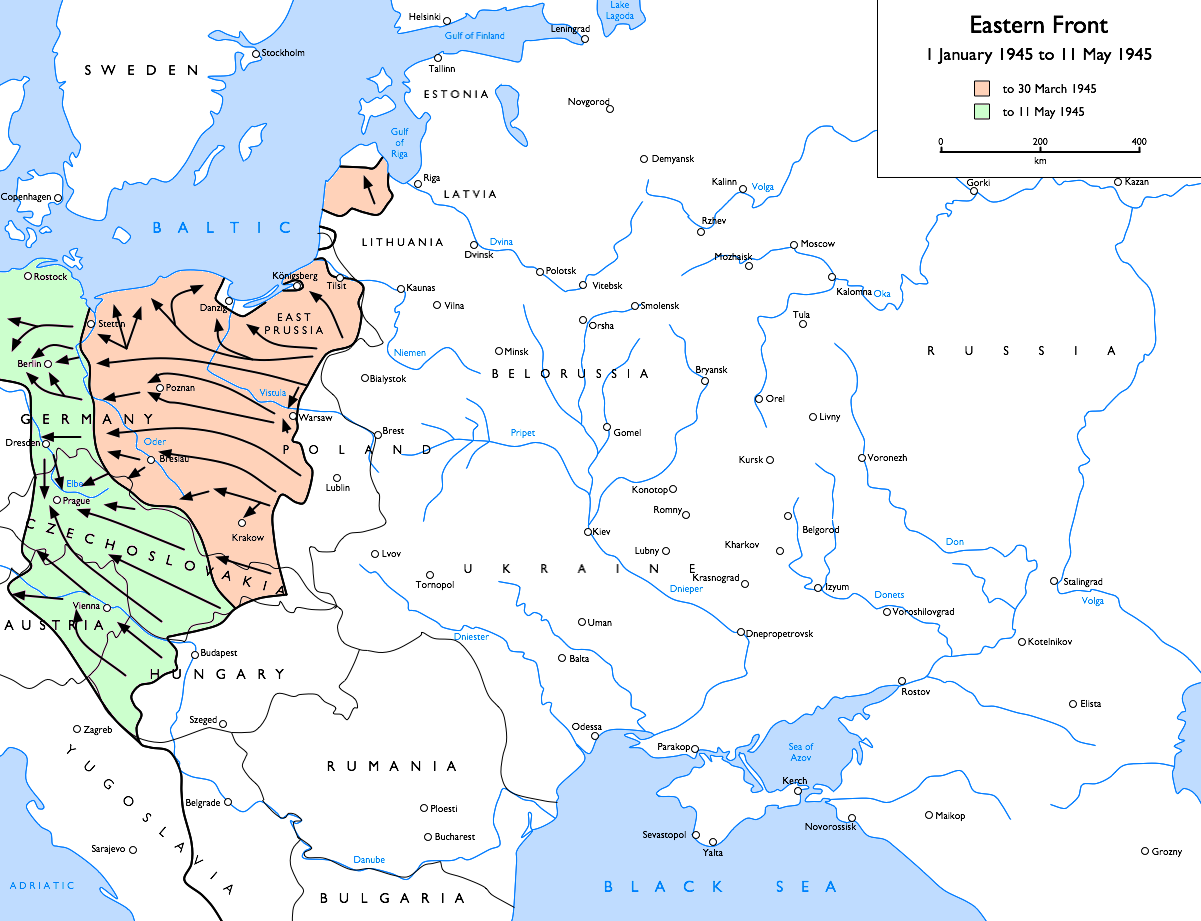 |
Above: German territorial losses on the Eastern Front during the Soviets’ Vistula-Oder Offensive (January 12 to February 2, 1945) and their East Prussian Offensive (January 13 to April 25, 1945). The grinding down of German forces during the Ardennes Offensive on the Western Front by Anglo-American and Canadian forces (December 16, 1944, to January 25, 1945) mortally weakened the Wehrmacht’s capacity to defend the nation in the East. But as a German general in British captivity observed correctly, “The fear of Russia will keep Germany fighting to the bitter end.”
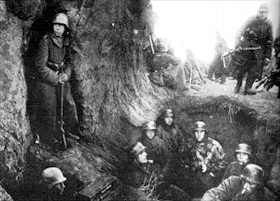 | 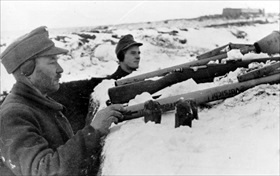 |
Left: Soldiers of the German 4th Army man positions on the East Prussian frontier on the eve of the Soviets’ East Prussian Offensive. That offensive began on January 13, 1945, and pushed the 4th Army steadily backwards toward the Baltic coast over a two week period. The army held its positions along the coast of the Vistula lagoon until overwhelmed by Soviet attacks in late March.
![]()
Right: Members of a Volkssturm (home guard) unit, each with a single-shot, shoulder-launched antitank Panzerfaust, man a position outside Koenigsberg, January 20, 1945. Roughly 200,000 civilians were trapped inside the city on January 24, 1945. During the Soviet assault the Vistula Spit, a peninsular stretch of land that separates the Vistula Lagoon from Gdańsk Bay in the Baltic Sea, became the last means of escape to the west. Civilians who tried to escape along the spit were often intercepted and killed by Soviet tanks and patrols. Two thousand civilians fled Koenigsberg each day and tried to reach the already crowded coastal town of Pillau (modern Baltiysk in Russia’s Kaliningrad Oblast). The final Soviet assault on Koenigsberg started on April 2 with a heavy bombardment of the city. The land route to Pillau was once again cut and civilians still in the city died by the thousands. On April 9 the German garrison surrendered, though some units did not surrender for another month.
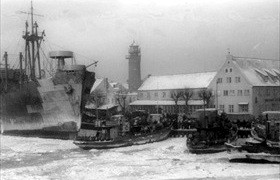 | 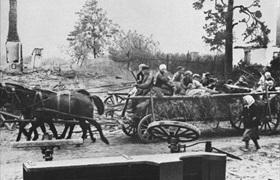 |
Above: Refugees from East Prussia fleeing west before the advancing Red Army in 1945. They fled, a good 450,000 between January and April 1945 by ship or small boats as seen in the left frame from the seaport of Pillau, which is now the Russian port of Baltiysk. The Soviets sank 200 unarmed ships transporting civilians across the Baltic Sea, killing thousands of refugees. Still others fled on foot or by wagon (right frame), some traversing an ice sheet, in appalling winter weather, with little or no food and no shelter except what they could find along the way. Thousands died from exposure or were killed during the evacuation, some by artillery fired to break up ice over which civilians fled, some by drowning after falling into frigid water. When Festung Koenigsberg’s garrison surrendered, military and civilian dead in the city were estimated at 42,000, with the Red Army claiming over 90,000 prisoners. About 120,000 survivors remained in the ruins of the devastated city. Comprising mostly women, children, and the elderly, plus a few others who had returned immediately after the fighting ceased, these survivors were held as slave laborers until 1949. The vast majority of German civilians remaining in Koenigsberg after 1945 died from disease or starvation, or in revenge-driven ethnic cleansing. The remaining 20,000 German residents were expelled by Soviet authorities in 1949–1950.
Soviet Assault on East Prussia, 1944–1945
![]()

 History buffs, there is good news! The Daily Chronicles of World War II is now available as an ebook for $4.99 on Amazon.com. Containing a year’s worth of dated entries from this website, the ebook brings the story of this tumultuous era to life in a compelling, authoritative, and succinct manner. Featuring inventive navigation aids, the ebook enables readers to instantly move forward or backward by month and date to different dated entries. Simple and elegant! Click
History buffs, there is good news! The Daily Chronicles of World War II is now available as an ebook for $4.99 on Amazon.com. Containing a year’s worth of dated entries from this website, the ebook brings the story of this tumultuous era to life in a compelling, authoritative, and succinct manner. Featuring inventive navigation aids, the ebook enables readers to instantly move forward or backward by month and date to different dated entries. Simple and elegant! Click 











